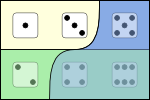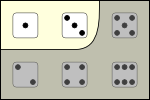
|

|
|
| A | B |
Fig. 2.1.2-1. Propositions expressed by two sentences (A) and their conjunction (B).
2.1.2. A truth function
We can begin to provide a single account of the laws outined in 2.1.1 by recalling our definition of entailment. In positive form, it says that a set Γ entails a sentence φ if and only if φ is T in every possible world in which each member of Γ is T. Restating our three laws in these terms, we have
φ is T in every possible world in which φ ∧ ψ is T
ψ is T in every possible world in which φ ∧ ψ is T
φ ∧ ψ is T in every possible world in which both φ and ψ are T
In short, φ ∧ ψ is true in a possible world if and only if both φ and ψ are true.
This means that the truth value of the compound φ ∧ ψ is determined by the truth values of the components φ and ψ, a fact we can express in the truth table below.
| φ | ψ | φ | ∧ | ψ |
| T | T | T | ||
| T | F | F | ||
| F | T | F | ||
| F | F | F |
This table shows the contribution of conjunction to the truth conditions of compound sentences formed using it, for it tells us how to determine the truth value of a conjunction φ ∧ ψ in any possible world once we know the truth values of the conjuncts φ and ψ. And the table also shows what lies behind the general laws of entailment that led us to it: it is because conjunction makes this sort of contribution to the meaning of sentences that those laws hold. A particular way of associating an output truth value with input truth values is a truth function, so we can say that conjunction expresses a truth function, and we can say the laws of entailment stated above reflect the character of the truth function that conjunction expresses.
It is worth pausing a moment to look at the way in which the proposition that is expressed by a conjunction is related to the propositions that are expressed by its components. Since a conjunction is false whenever either component is false, it rules out any possibility ruled out by either component; and, since the possibilities ruled out are an indication of the information a sentence contains, we can say that a conjunction contains all the information contained in its components. This means that the effect of conjunction is to add up informational content. Now, more information means fewer possibilities left open and, looking at the table in these terms, we see that a conjunction leaves open only the possibilities left open by both components. The range of possibilities it leaves open is the region in the full space of possibilities where the ranges of possibilities left open by the two components overlap.
For example, the sentence The number shown by the die is odd and less than 4 can be analyzed as the conjunction The number shown by the die is odd ∧ the number shown by the die is less than 4. The first component rules out possibilities where the die shows 2, 4, or 6 and the second rules out possibilities where it shows 4, 5, or 6. The conjunction rules out all these possibilities—that is, any possibility where the die shows 2, 4, 5, or 6. Looking at things in terms of the possibilities left open, the first component leaves open those where the die shows 1, 3, or 5 and the second leaves open those where it shows 1, 2, or 3. The conjunction leaves open a possibility when it is left open by both components; that is, it leaves open those where the die shows 1 or 3.
This is shown pictorially in Figure 2.1.2-1 below.
Here, each rectangle represents the space of all possible worlds. The die faces mark regions consisting of the possible worlds in which the die shows one or another number. In Figure 2.1.2-1A, the possibilities ruled out by the first component are at the bottom in the region hatched in red from lower left to upper right while those ruled out by the second component occupy the region at the right hatched in green from upper left to lower right. The possibilities left open by the first component then form the region at the top outside the red hatching while those left open by the second are in the region at the left outside the green hatching. Figure 2.1.2-1B shows the proposition expressed by the conjunction of these two sentences. The possibilities ruled out add up to form the region hatched in blue; those left open are in the unhatched region at the top left where the ranges of possibilities left open by the original components overlap. These diagrams can be compared to the truth table for conjunction. The sort of worlds covered by first row of the table, worlds where both components are true, appear at the top left of the 2.1.2-1A; the other rows of the table correspond to the remaining three regions of the this diagram—those at the top right, the bottom left, and the bottom right, respectively.